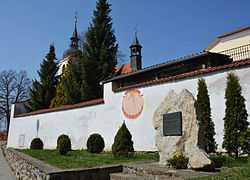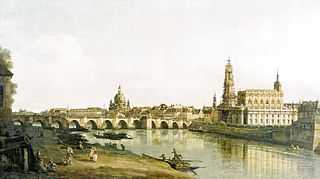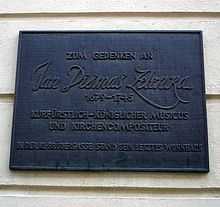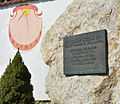Jan Dismas Zelenka

Jan Dismas Zelenka (baptised Jan Lukáš Zelenka; 16 October 1679 – 23 December 1745),[1] also known as Johann Dismas Zelenka, was a Czech composer and musician of the Baroque period. His music is admired for its harmonic inventiveness and counterpoint.
Life

Zelenka was born in Louňovice pod Blaníkem (German: Launiowitz), a small market town southeast of Prague, in Bohemia. He was the eldest of the eight children born to Marie Magdalena (née Hájek) and Jiří Zelenka. The middle name Dismas is probably his confirmation name.[2] Zelenka's father was a schoolmaster and organist in Launiowitz; nothing more is known with certainty about Zelenka's early years. He received his musical training at the Jesuit college Clementinum in Prague.[3] His instrument was the violone (or bass viol). His first works, all oratorios, were written in his Prague student days.
Zelenka served Baron von Hartig in Prague, before his appointment as violone player in Dresden's royal orchestra around 1710. This Baron von Hartig might be identical with 'Freiherr von Hartig', the first patron and director of the Prague Musical Academy, most probably identical with the imperial governor resident Freiherr Ludwig Joseph von Hartig (1685-1736) a well-known connoisseur and collector of music.[4]
Possibly on Count Hartig's recommendation, Zelenka was accepted to the Dresden Hofkapelle (court orchestra) as a double bass player with a salary of 300 thalers. Zelenka arrived in Dresden in either 1710 or 1711 and the favourable conditions for music making at Dresden gave added impetus to his creativity, particularly with respect to the composition of sacred music for the Catholic court church. [5] His first opus in Dresden was a Mass, the "Missa Sanctae Caeciliae" (c. 1711).[6] His emigration from Bohemia, for unknown reasons, was most likely sudden. Some monographs give various personal reasons why he left, but the truth is still unknown.
Zelenka continued his education in Vienna under the Habsburg Imperial Kapellmeister Johann Joseph Fux beginning in 1716; he was back in Dresden by 1719. Whether or not he ever went to Venice is unclear, but a Saxon court document of 1715 records a royal cash advance for such a journey to Zelenka along with fellow composers Christian Petzold and Johann Georg Pisendel.
Except for a trip back to Prague in 1723, where Zelenka conducted the première of one of his major secular works, Sub olea pacis et palma virtutis conspicua orbi regia Bohemiae Corona, a melodrama about St. Wenceslas on the occasion of the coronation of Charles VI, he remained in Dresden.[7] While in Prague he concentrated on instrumental composition, as the autograph of the score of Concerto à 8 concertanti confirms: "Six concerti written in a hurry in Prague in 1723".

Back in Dresden, he started as assistant to Kapellmeister Johann David Heinichen but gradually took over Heinichen's responsibilities as the latter's health declined. After Heinichen died in 1729, Zelenka applied for the now-vacant post of Kapellmeister but it was given instead (in 1733) to the eminent opera composer Johann Adolf Hasse, reflecting the court's fashionable interest in opera as opposed to the liturgical music that was Zelenka's forte. Instead, in 1735, Zelenka was given the title of "church composer" – "Compositeur of the Royal Court Capelle" which none other than Johann Sebastian Bach himself had applied for in 1733 and did in fact receive it in 1736, replacing Zelenka, who was again disappointed by the court's decision; but despite this he continued to compose assiduously. Such social failures might have turned him inward to exercise his free creative spirit and produce innovative work with unique qualities.[8]
J.S. Bach held Zelenka in high esteem, as evidenced by a letter of 13 January 1775 from his great son C.P.E. Bach to Bach biographer Johann Nikolaus Forkel. Zelenka was actually a guest in Bach's Leipzig home at one point. Bach thought enough of Zelenka to have some of his works copied; e.g. he had his eldest son, Wilhelm Friedemann, copy out the Amen from Zelenka's third Magnificat (ZWV 108) for use in Leipzig's St. Thomas's church where J.S. Bach was cantor for the last 2 1/2 decades of his life.[3]
In addition to composing, Zelenka taught throughout his life, instructing a number of prominent musicians of that time, e.g. Johann Joachim Quantz (Frederick the Great of Prussia's longtime court flautist and flute teacher), J. G. Barter and J. G. Roellig. His close friends included eminent composers Georg Philipp Telemann, Johann Georg Pisendel and Sylvius Leopold Weiss.

Zelenka died of dropsy in Dresden on December 23, 1745, and was buried on Christmas Eve.[9] His last works were never performed in his lifetime. He never married and had no children; his compositions and musical estate were purchased from his beneficiaries by Electress of Saxony Maria Josepha of Austria, and after his death were closely guarded (in contrast to their lack of appreciation when he was alive) and considered valuable court possessions. Telemann, with Pisendel's assistance, tried unsuccessfully to publish Zelenka's "Responsoria". He wrote on 17 April 1756, with undisguised contempt for publishers' disinterest in the work, that "the complete manuscript will be at the Dresden court, kept under lock and key as something very rare...".
There is no confirmed portrait of Zelenka, but worthy of mention is a mirror-image black-and-white copy of a well-known portrait of his old teacher Fux which has been passed off as a picture of Zelenka on several respected websites.
Musical style
Zelenka's pieces are characterized by very daring compositional structure, with a highly spirited harmonic invention and perfection of the art of counterpoint. His works are often virtuosic and difficult to perform, but always fresh and surprising, with sudden turns of harmony, being always a challenge for their interpreters. In particular, his writing for bass instruments is far more demanding than that of other composers of his era. His instrumental works (the trio sonatas, capricci, and concertos) are exemplary models of his early style (1710s–1720s). The six trio sonatas demand high virtuosity and expressive sensitivity from performers. As Zelenka was himself a violone player, he was known to write fast-moving continuo parts with driving and complicated rhythm.
Zelenka was aware of the music in different regions of Europe. He wrote complex fugues, ornate operatic arias, galant-style dances, baroque recitatives, Palestrina-like chorales, and virtuosic concertos. Zelenka's musical language is closest to Bach's, especially in its richness of contrapuntal harmonies and ingenious usage of fugal themes. Nevertheless, Zelenka's language is idiosyncratic in its unexpected harmonic twists, obsession with chromatic harmonies, huge usage of syncopated and tuplet figures, and unusually long phrases full of varied musical ideas. He is sometimes considered as Bach's Catholic counterpart, in his works.
Zelenka's music is influenced by Czech folk music. In this respect, he continues the tradition of the production of specific Czech national music, initiated by Adam Michna z Otradovic and brought to its culmination later, in works by Bedřich Smetana and Antonín Dvořák in the nineteenth century and Leoš Janáček and Bohuslav Martinů in the twentieth century.
In 2013 Damian Thompson wrote of Zelenka, "He belongs to a band of mavericks in musical history whose experiments with harmony seem to catapult them into another generation".[10]
Rediscovery
The rediscovery of Jan Dismas Zelenka's work is attributed to Bedřich Smetana, who rewrote some scores from the archives in Dresden and introduced one of the composer's orchestral suites in Prague's New Town Theatre festivals in 1863.
It was mistakenly assumed that many of Zelenka's autograph scores were destroyed during the fire-bombing of Dresden in February 1945. However, the scores were not kept in the Katholische Hofkirche but in the basement of the Japanese Palace, north of the river Elbe. Some are certainly missing, but this probably happened gradually – and the lost scores represent only a small proportion of his extant works.
Interest in Zelenka's music has begun to grow, especially since the end of the 1950s. By the late 1960s and early 1970s all Zelenka's instrumental compositions and selected liturgical music were published in Czechoslovakia. The most important revival was demonstrated by the first presentation of selected compositions by Czech conductor Milan Munclinger and his ensemble Ars Rediviva. They were three trio sonatas in 1958–60, Sinfonia concertante in 1963 and the exquisite interpretation of "Lamentationes Jeremiae prophetae" with soloists Karl Berman, Nedda Casei and Theo Altmeyer in 1969. The music of Zelenka has become widely known and available since that time, through recordings and sparked the interest of musicians such as, Milan Munclinger (above), Heinz Holliger and Reinhard Goebel.
More than half of Zelenka's works have now been recorded, mostly in the Czech Republic and Germany. Such recordings include the masses Missa Purificationis, Missa Sanctissimae trinitatis, Missa votiva, Missa Sancti Josephi, and his secular works "Sub olea pacis" and "Il Diamante", mostly performed by new Czech ensembles using original instruments and interpretational techniques of the Baroque era - above all Musica Florea, Collegium 1704, Ensemble Inégal, and Capella Regia Musicalis.
In honor of Jan Dismas Zelenka, "The Autumn Music Festival under Blaník" (Podblanický hudební podzim in Czech) was founded in 1984. Since then, performances of Zelenka's music have regularly taken place in and around his birthplace.
Works
Zelenka's complete compositions are listed in Wolfgang Reich's thematic catalogue Jan Dismas Zelenka: Thematisch-systematisches Verzeichnis der musikalischen Werke (ZWV)[11] ("Systematic thematic catalogue of musical works") and in Janice Stockigt's monograph Jan Dismas Zelenka: A Bohemian Musician at the Court of Dresden.[12]
The total number of Zelenka's known and attributed opus numbered works is 249. Sacred vocal-instrumental music is at the center of his compositions, and include over 20 masses, four extensive oratorios and requiems, two Magnificats and Te Deum settings, 13 litanies, many psalms, hymns, antiphons. Zelenka also wrote a number of purely instrumental works – six trio or quartet sonatas, five capricci, one "Hipocondrie" as well as Concertos, Overtures and Symphonies.
Sacred music
The most appreciated of Zelenka's sacred works are probably his masses, above all his Missa Purificationis (ZWV 16, his last mass to include brass instruments) and his final five pieces (ZWV 17–21), commonly called "High Mass" compositions, written between 1736 and 1741 and considered as Zelenka's compositional peak. The last three were also called "Missae ultimae" (Last Masses). The following list contains only the most important sacred works, that have been sufficiently explored to date.
Masses and requiems
- Missa Sancti Spiritus
- Missa Sancti Josephi
- Missa Purificationis Beatae Virginis Mariae
- Missa Sanctissimae Trinitatis
- Missa Votiva
- Missa Dei Patris
- Missa Dei Filii
- Missa Omnium Sanctorum
- Requiem in C Minor
- Requiem in D Minor
Oratorios
- Il Serpente di Bronzo
- Gesù al Calvario
- I penitenti al sepolchro del Redentore
Litanies
- Litaniae de Venerabili Sacramento
- Litaniae Lauretanae
- Litaniae Lauretanae "Consolatrix afflictorum"
- Litaniae Lauretanae "Salus infirmorum"
- Litaniae Omnium Sanctorum
- Litaniae Xaverianae
Psalms and hymn settings
- Dixit Dominus
- Confitebor tibi Domine
- In exitu Israel
- Lauda Jerusalem
- Laudate pueri
- Ave maris stella in D Minor
- Chvalte Boha silného
- Ave Regina coelorum
- Regina coeli
- Salve Regina
- De Profundus (Psalm 130)
Other liturgical and spiritual works
- Te Deum in D Major (2 settings)
- Magnificat in C Major and D Major
- Miserere in D Minor and C minor
- Lamentationes Ieremiae Prophetae
- XXVII Responsoria pro hebdomada
Secular works
Zelenka composed only a few extensive vocal-instrumental pieces on secular themes, but one of them – Sub olea pacis et palma virtutis--Melodrama de St. Wenceslao (1723) – not only represents one of the high points in baroque music, but transcends it, as with many others of Zelenka's works. It is a monumental opus with aspects of melodrama, oratory and contemporary opera, composed for the coronation of Charles VI by the Czech king and celebrating the memory of the greatest Czech saint and patron of Bohemia, prince St. Wenceslaus (Václav), one of the founders of the Czech state.
Vocal-instrumental works
- Sub olea pacis et palma virtutis (conspicua orbi regia Bohemiae Corona – Melodrama de Sancto Wenceslao)
- Il Diamante
Instrumental works
- Trio or Quartet Sonatas Nos. 1–6
- Capriccios Nos. 1–5
- Concerto à 8 Concertanti
- Hipocondrie à 7 Concertanti
- Overture à 7 Concertanti
- Simphonie à 8 Concertanti
Selected discography
- Orchestrální skladby – Overture, ZWV 188, Sinfonia concertante, ZWV 189, Ars Rediviva, Martinů Chamber Orchestra, 1963, LP, Supraphon
- Lamentationes – abbreviated version of "Lamentationes Ieremiae prophatae", Ars Rediviva (Milan Munclinger), 1969, LP, Supraphon
- The Orchestral Works – Camerata Bern, 3 CDs, 1989, Universal
- Trio Sonatas 1–6, 2 CDs, 1993, Studio Matouš
- Missa Sanctissimae Trinitatis, Musica Florea (Marek Štryncl), CD, 1994, Studio Matouš
- Requiem In D Minor; ZWV 48, Miserere In C Minor; Psalm 50, ZWV 57, CD, 1995, Supraphon
- Magnificat, ZWV 108; De profundis, ZWV 96; Litaniæ Omnium Sanctorum, ZWV 153, Salve Regina, ZWV 137) – Czech Philharmonic Orchestra and chorus, CD, 1998, Supraphon
- Missa Dei Patris – Barockorchester Stuttgart, Kammerchor Stuttgart (Frieder Bernius), CD, 2001, Carus
- Sub olea pacis et palma virtutis – Musica Florea, Musica Aeterna, Ensemble Philidor, Boni Pueri (Marek Štryncl), 2 CDs, 2001, Supraphon; world premiere recording
- Gesù Al Calvario – Das Kleine Konzert, Rheinische Kantorei (Hermann Max), CD, 2001, Capriccio
- Lamentations Of Jeremiah – Chandos Baroque Players, CD, 2002, Helios
- Complete Orchestral Works – Das Neu-Eröffnete Orchestre (Jürgen Sonnentheil), 3 CDs, 2002, CPO
- I penitenti a sepolcro del Redentore, Capella Regia Musicalis (Robert Hugo) & soloists, incl.mezzo-soprano Magdalena Kožená, CD, 2004, Supraphon
- I penitenti a sepolcro del Redentore ZWV 63, Collegium 1704, Collegium Vocale 1704 (Václav Luks), CD, 2009, Zig-Zag Territoires
- Missa Dei Filii, Litaniae Laurentanae "Salus Infirmorum" – Taffelmusik (Frieder Bernius), CD, 2004, Deutsche Harmonia Mundi
- Composizioni per orchestra – Collegium 1704 (Václav Luks), CD, 2005, Supraphon
- Il serpente di bronzo – Ensemble Inégal (Adam Viktora), CD, 2005, Nibiru
- Missa purificationis Beatae Virginis Mariae – Ensemble Inégal (Adam Viktora), CD, 2007, Nibiru
- Missa votiva ZWV 18 – Collegium 1704, Collegium Vocale 1704 (Václav Luks), CD, 2008, Zig-Zag Territoires
- Il Diamante (Serenata ZWV 177), Ensemble Inégal, Prague Baroque Soloists (Adam Viktora), 2 CD, 2009, Nibiru
- Missa Sancti Josephi ZWV 14, Litaniae Xaverianae ZWV 155 – Ensemble Inégal, Prague Baroque Soloists (Adam Viktora), CD, 2010, Nibiru
- Officium Defunctorum ZWV 47 / Requiem ZWV 46, Collegium 1704 / Collegium Vocale 1704 (Václav Luks), 2 CDs, 2011, Accent (Note 1 Musikvertrieb)
- Sepolcri ZWV 58–60. Collegium Marianum, Jana Semerádová, Praha 2011, Music from Eighteenth-Century Prague
- Missa Omnium Sanctorum ZWV 21, Barbara dira effera ZWV 164, Christe eleison ZWV 29 - Ensemble Inégal, Prague Barogue Soloists (Adam Viktora), CD, 2011 Nibiru
- Sonatas – Ensemble Marsyas with Monica Huggett, SACD and digital download, 2012, Linn Records
- Missa Sanctissimae Trinitatis ZWV 17, Gaude laetare ZWV 168 - Ensemble Inégal, Prague Baroque Soloists (Adam Viktora), CD, 2012 Nibiru
Gallery
The Zelenka memorial in Louňovice pod Blaníkem, Czech Republic includes a 2012 sundial to mark the 333rd anniversary of his birth. Graphic design and painting is by Milan Houdek, text by Vladimír Hirsch: "Tempus fugit - opus permanens est" (above), "Ad honorem artis tui, ad gloriam Dei et patriae petentis".
-

Memorial
-

Sundial
-

Memorial with sundial
References
- ↑ Slonimsky, Nicolas (1978). "Zelenka, Jan Dismas". Baker's Biographical dictionary of musicians. (6th ed.). New York: Schirmer Books. p. 1940. ISBN 0-02-870240-9.
- ↑ David Charlton: Jan Dismas Zelenka, a detailed biography at Classical Net
- ↑ 3.0 3.1 "Jan Dismas Zelenka". bach-cantatas.com. 2008. Retrieved 2010-07-18.
- ↑ Editing Weiss for theSämtliche Werke: The composer's contribution to the London and Dresden manuscripts, at igor.gold.ac.uk
- ↑ David Charlton: Jan Dismas Zelenka, a detailed biography at Classical Net
- ↑ Lo Mejor De La Musica Clasica
- ↑ Jan Dismas ZELENKA, biography at baroquemusic.org
- ↑ Vladimír Hirsch: Jan Dismas Zelenka neglected and rediscovered , , J.D.Zelenka – Opomíjený génius (in Czech)
- ↑ Jan Dismas ZELENKA, biography at baroquemusic.org
- ↑ Thompson, Damian (27 July 2013). "Why has nobody heard of the miraculous Czech composer Zelenka?". The Spectator. Retrieved 2013-07-27.
- ↑ Jan Dismas Zelenka: thematisch-systematisches Verzeichnis der musikalischen Werke (ZWV)
- ↑ Janice B. Stockigt: Jan Dismas Zelenka – A Bohemian musician at the court of Dresden, Oxford University Press
Sources
External links
-
 Media related to Jan Dismas Zelenka at Wikimedia Commons
Media related to Jan Dismas Zelenka at Wikimedia Commons - The "Discover Zelenka" website, which includes a database of works and recordings. (It is even possible to get an up-to-date list of unrecorded works).
- The Zelenka Forum
- Jan Dismas Zelenka Detailed Biography of classical.net
- Wolfgang Reich's catalog of Zelenka's works
- Janice Stockigt: Jan Dismas Zelenka: A Bohemian Musician at the Court of Dresden
- Jan Dismas Zelenka (www.bach-cantatas.com)
- Discography
- Music on Net
- Free scores by Jan Dismas Zelenka at the International Music Score Library Project
- Free scores by Jan Dismas Zelenka in the Choral Public Domain Library (ChoralWiki)
|